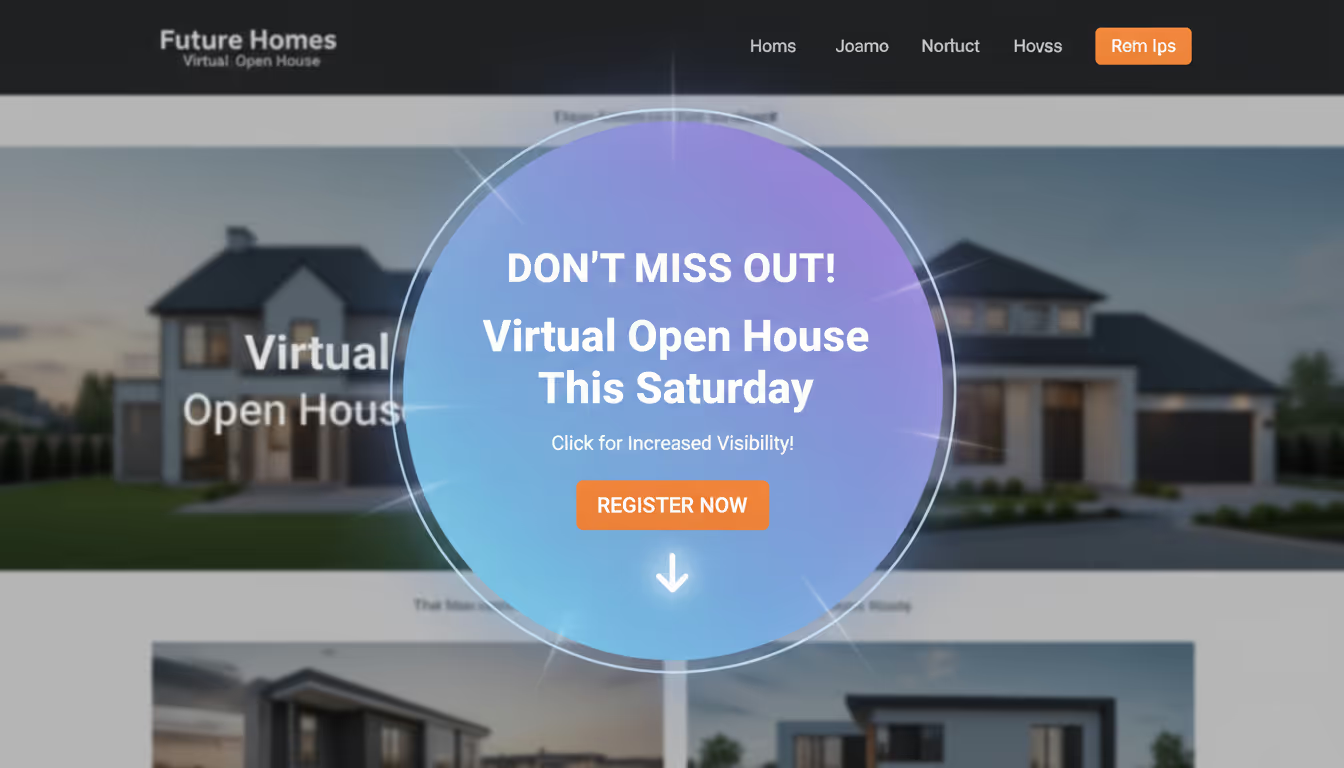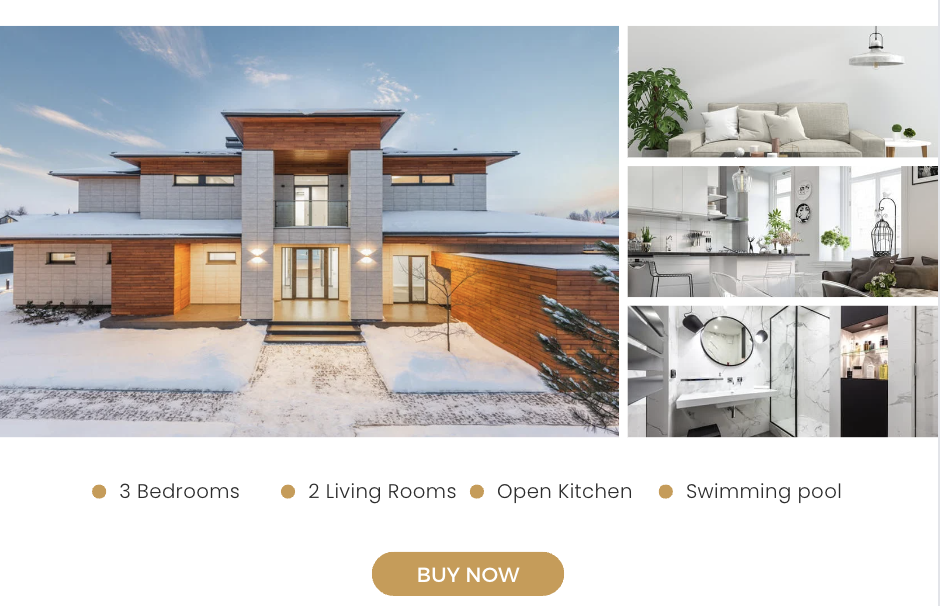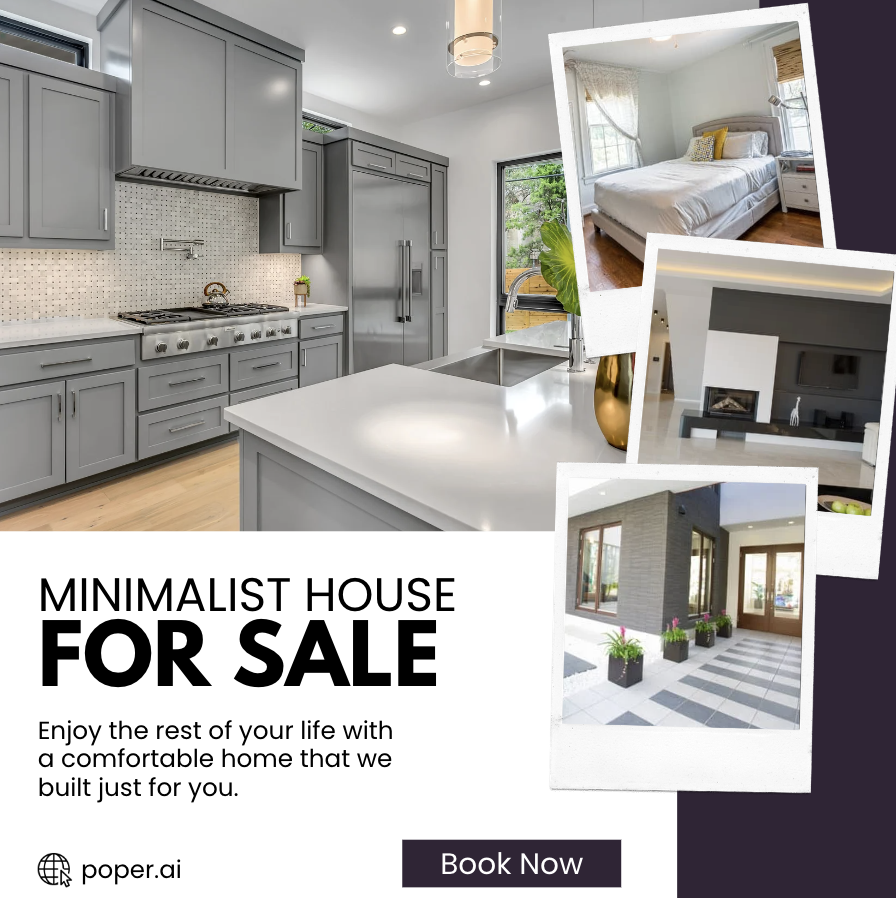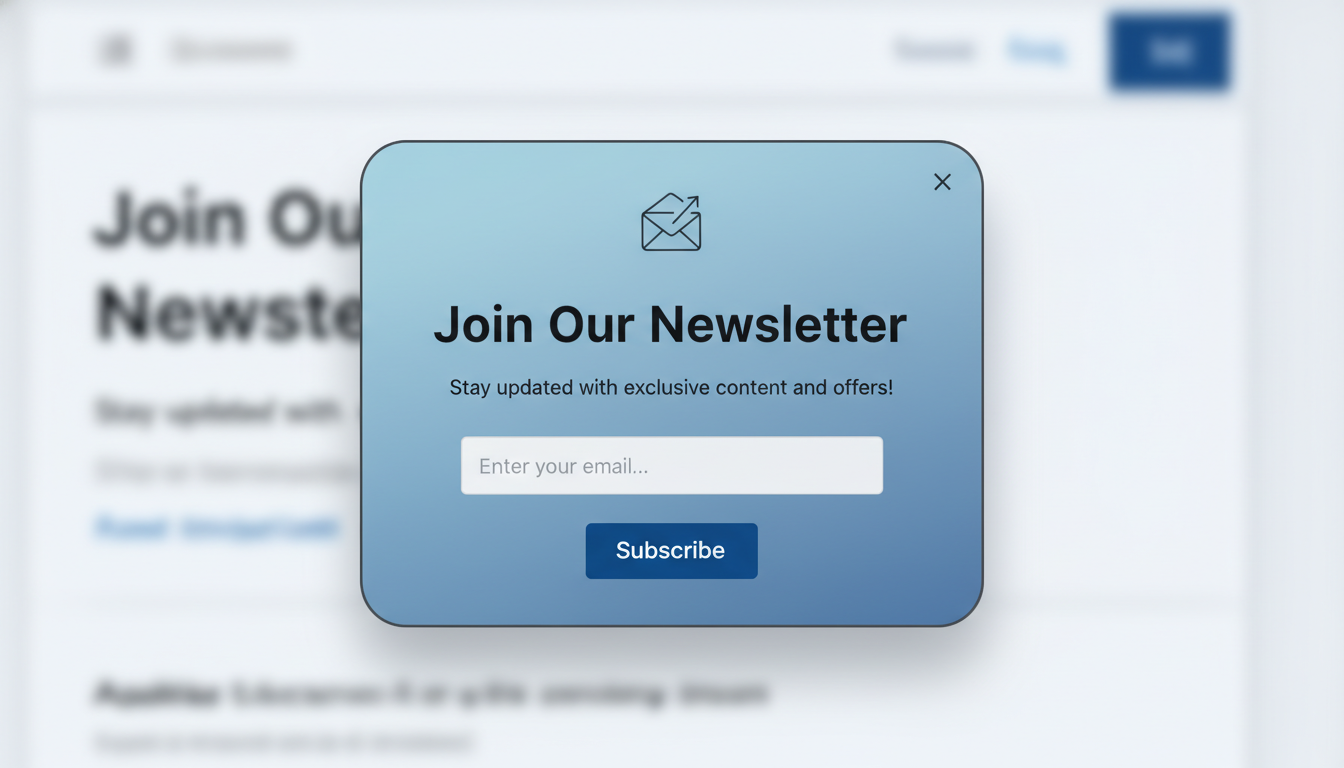Virtual open houses have transformed how real estate and educational institutions showcase their offerings, adapting to a more digital-centric world. These events allow potential buyers or students to explore properties or campuses from the comfort of their homes, making effective promotion essential to attract a significant audience.
Marketing is no longer about the stuff that you make, but about the stories you tell.
Seth Godin
This quote underscores the importance of engaging storytelling in marketing virtual open houses, where popups can play a pivotal role. They not only grab attention but also convey essential information succinctly, making them a powerful tool in digital marketing arsenals.
3 Benefits of Using Popups for Virtual Open Houses

1. Increased Visibility
One of the primary advantages of using popups in promoting virtual open houses is their ability to capture user attention effectively. When a visitor lands on your website, a well-designed popup can immediately highlight the upcoming virtual event, ensuring it doesn't go unnoticed. This increased visibility is crucial, especially in a crowded digital landscape where users are bombarded with information. Effective popups serve as visual cues that guide potential attendees to your event, increasing the likelihood of their participation.
2. Enhanced User Engagement
Popups aren't just about catching the eye; they're also about holding the user's interest. Interactive popups, such as those with video teasers or virtual tour snippets, invite users to engage more deeply with the content. Building anticipation for the virtual open house can be achieved by incorporating elements like teaser videos, countdown timers, or interactive quizzes within the popups, making the event feel more exciting and engaging.
3. Higher Conversion Rates
The ultimate goal of any marketing tool is to convert visitors into participants, and popups are particularly effective at this. By presenting users with a straightforward call-to-action (CTA), such as "Register Now" or "Reserve Your Spot," popups can significantly increase the conversion rates for event registrations. Moreover, sharing examples of successful popup campaigns can illustrate their potential impact, showing how other organizations have successfully leveraged popups to boost attendance and engagement in their virtual open houses.
Types of Popups for Promoting Virtual Open Houses

Welcome Popups
These are typically the first interaction a visitor will have with your pop-up strategy. Welcome popups serve as a friendly greeting mechanism, introducing visitors to the virtual open house. They can provide essential information such as the date and time of the event, key highlights, and a CTA to learn more or register. This immediate engagement helps set the stage for further interactions and can be pivotal in building initial interest.
Exit-Intent Popups
Designed to trigger when a user is about to leave the website, exit-intent popups are a last-ditch effort to capture interest or convert a visitor. They can offer special incentives like exclusive previews, additional content, or a reminder of the benefits of attending the virtual open house, providing a compelling reason for users to reconsider their departure and possibly commit to registering.
Scroll-Triggered Popups
As visitors navigate through your site, scroll-triggered popups can appear at strategic points in the journey—perhaps after reading about the benefits of the virtual open house or upon reaching a particularly engaging section of content. These popups can highlight further details about the event, emphasize the value of attending, or offer a direct invitation to register.
Timed Popups
Timing can play a crucial role in how effective a popup is. Timed popups are set to appear after the visitor has spent a predetermined amount of time on the site, ensuring that they are somewhat engaged with the content before being prompted with a CTA. This method can create a sense of urgency, especially if coupled with a countdown to the event start, urging users to register before it's too late.
Interactive Popups
To make the engagement more dynamic, interactive popups that include quizzes, polls, or even short games can be very effective. These popups not only entertain but also gather useful information about the potential attendees, such as their interests or feedback on what they hope to see at the event. This data can be invaluable in tailoring the open house to meet the audience's expectations.
Planning Your Popup Strategy

Setting Clear Objectives
Before launching any popup campaign, it is critical to define clear, measurable goals. What do you hope to achieve with your popups? Whether it's increasing event registrations, boosting engagement, or gathering user data, having a well-defined objective will guide the design and implementation of your popups. Align these objectives with your overall marketing strategy for the virtual open house to ensure consistency and effectiveness across all channels.
Identifying Target Audience
Understanding who your audience is plays a fundamental role in crafting a successful popup strategy. Segmenting your audience based on demographics, interests, or previous interactions with your site can help tailor your popups to meet their specific needs and preferences. This targeted approach not only enhances the user experience but also increases the likelihood of achieving your campaign objectives.
Designing Effective Popups

Crafting Compelling Headlines and CTAs
The success of a popup often hinges on its ability to quickly convey its message. Compelling headlines grab attention and draw users in, while effective call-to-actions (CTAs) motivate them to take the desired action. Headlines should be concise, clear, and directly related to the benefits of attending the virtual open house. Similarly, CTAs like "Sign Up Now," "Join Us," or "Reserve Your Spot" should create a sense of urgency and clarity on what the user is expected to do.
Visual Design Best Practices
The visual appeal of your popups can significantly impact their effectiveness. Choosing the right colors, fonts, and images that align with your brand and the theme of the virtual open house is crucial. Ensure that the design is not only attractive but also functional, particularly in terms of mobile responsiveness. Since a large portion of users may interact with your site on mobile devices, it's essential that popups are optimized for smaller screens to maintain a seamless user experience.
Writing Engaging Popup Content
Content within your popups should be concise and persuasive. It needs to communicate the value of the virtual open house quickly and efficiently. Include key points about what attendees will gain by participating, such as exclusive insights, network opportunities, or early bird benefits. Remember, every word counts in maintaining engagement and persuading users to take action.
Implementing Popups on Your Website

Integration with CMS Platforms
Seamless integration of popups with your existing Content Management System (CMS) is essential for maintaining site stability and user experience. Most modern CMS platforms, like WordPress, Joomla, or even custom solutions used by Grigora, offer plugins and tools that make popup integration straightforward. Choosing the right tool can depend on your specific needs—whether it’s for ease of use, customization options, or advanced tracking capabilities. For those who prefer more control, custom coding your popups might be the way to go, though this requires technical expertise.
Ensuring Seamless User Experience
The effectiveness of your popups also depends on their placement and how they interact with users. Avoid intrusive placements that can annoy users and potentially drive them away from your site. Popups should be easily dismissible and should not interfere with the ability to navigate the site. Placing them strategically so they feel like a natural part of the user’s journey can enhance their impact without compromising the user experience.
Timing and Placement of Popups

Strategic Placement for Maximum Impact
The placement of popups can significantly influence their effectiveness. To achieve the best results, place popups in locations where they are most likely to engage users without disrupting their experience. For example, a welcome popup might best serve its purpose when placed on the homepage or main event page, while an exit-intent popup could be more effective on pages with high bounce rates or after a user has spent a significant amount of time without engaging. Balancing visibility and user experience is key to ensuring that the popups enhance the site rather than detract from it.
Optimal Timing Strategies
The timing of when a popup appears is just as crucial as where it appears. Timing popups based on user behavior—such as after a certain amount of time spent on the site, or when a user scrolls to a specific section—can increase the relevance and perceived value of the information provided. Using behavioral triggers, such as attempting to leave the site or showing high engagement with content, can also help tailor the experience to the user's actions, making the popup feel more personalized and less intrusive.
Promoting Event Registration with Popups

Incentivizing Registration
Offering incentives through popups can significantly boost registration rates for virtual open houses. Early bird discounts, exclusive access to additional content, or special features available only to registered users can create compelling reasons for visitors to sign up. Highlighting the unique aspects of the event, such as keynote speakers, special sessions, or interactive components, can also be effectively communicated through popups to enhance the attractiveness of registering.
Collecting Registrations Efficiently
To maximize the effectiveness of your registration popups, ensure the forms are user-friendly and require minimal input from the user. Streamlining the registration process reduces friction and increases the likelihood of completion. Integrating these popups with email marketing tools can automate the follow-up process, keeping potential attendees engaged and informed. This integration not only helps in maintaining a smooth registration process but also in building a relationship with the registrants leading up to the event.
Engaging Attendees Before the Event

Pre-Event Surveys and Polls
Engaging attendees even before the event starts can significantly enhance their overall experience and satisfaction. Pre-event surveys and polls facilitated through popups can gather valuable insights into what the attendees expect or desire from the event. This feedback can be used to tailor the event more closely to the audience's interests, increasing their engagement and anticipation. Additionally, this interaction helps build a sense of community and involvement, making attendees feel like active participants rather than just spectators.
Countdown Timers
Countdown timers in popups are a fantastic way to create a sense of urgency and excitement as the event approaches. These timers remind attendees of the upcoming event and help keep it top of mind. Implementing a countdown can also spur those who have not yet registered to take action before it's too late, leveraging a natural human tendency to respond to time-sensitive opportunities.
Enhancing User Engagement During the Event
Live Popups

During the virtual open house, live popups can play a crucial role in maintaining and enhancing attendee engagement. These popups can be used for real-time announcements, updates, or special highlights throughout the event. For example, alerting attendees about an upcoming session or last-minute changes in the schedule keeps everyone informed and engaged. Additionally, live popups can facilitate interactive elements like live polls or Q&A sessions, fostering a dynamic interaction between the hosts and the audience.
Feedback and Interaction
Collecting real-time feedback during the event is invaluable for gauging the success of your engagement strategies and making any necessary adjustments. Popups that solicit feedback or encourage questions can enhance the participatory nature of the event. This immediate interaction helps create a more responsive and attendee-focused experience, which can significantly boost satisfaction and retention rates.
How to Create Popups for Promoting Virtual Open Houses with Poper
To get started with Poper, visit the Poper website and sign up for an account. Once you’ve signed up, log in to access the dashboard.
Step 1: Log In to Poper.ai
Sign in to your Poper.ai account and access your dashboard. Click “New Popup” to begin creating your virtual open house popup.
Step 2: Choose a Template
Browse templates under Event Promotion, Lead Generation, or Announcements. Select a layout designed to highlight upcoming events or registrations.
OR
Start from scratch using Poper’s drag-and-drop editor for full creative control.
OR
Use Poper AI to generate a customized virtual open house popup based on your prompt (e.g., “Create a popup to promote a virtual open house for a 3-bedroom home”).
Step 3: Customize the Design
Use Poper’s design tools to align the popup with your brand and property listing.
Background colors: Choose clean, inviting tones that convey professionalism and trust
Images & visuals: Add property photos, agent headshots, or icons representing live tours or video calls
Messaging:
- Headline examples:
- “Join Our Virtual Open House”
- “Tour This Home Live—From Anywhere”
- “You’re Invited: Virtual Open House This Weekend”
- Supporting text:
- “Explore this beautiful home online and ask questions in real time.”
- “Reserve your spot for our upcoming virtual tour.”
- Headline examples:
Call-to-action buttons:
- Register Now
- Save My Spot
- Join the Virtual Tour
Step 4: Add Interactive Elements
Increase engagement by adding simple and relevant form fields such as:
Name
Email address
Preferred time slot (optional)
Optional interactive elements include:
Countdown timers to create urgency
Calendar integration to save the event date
One-click registration buttons
These features help make signing up quick and frictionless.
Step 5: Configure Display Rules
Control when and where your virtual open house popup appears to maximize registrations.
Triggers:
- On page load
- After scrolling
- After a time delay
- Exit intent
Placement:
- Property listing pages
- Homepage banners
- Blog posts or neighborhood guides
- Landing pages for featured homes
Step 6: Publish Your Popup
Preview your popup to ensure it looks great on both desktop and mobile devices. Once ready, click Publish.
Use Poper.ai’s analytics dashboard to track key metrics such as impressions, clicks, and registrations. Optimize based on performance insights.
Step 7: Preview, Test, and Optimize
Run A/B tests to refine your popup by experimenting with different:
Headlines
Property images
CTA buttons
Event timings or messaging
Testing helps identify what drives the highest virtual open house attendance.
Using Insights for Continuous Improvement
Regularly review the performance data and make necessary adjustments to your popups. This continuous improvement approach ensures your popups remain effective and aligned with your goals.
Frequently Asked Questions (FAQs)
What are the best types of popups for promoting virtual open houses?
The best types of popups for promoting virtual open houses include welcome popups, exit-intent popups, scroll-triggered popups, timed popups, and interactive popups. Each type serves a specific purpose, from greeting visitors to capturing leads before they leave your website.
How can I ensure my popups are not intrusive?
To ensure your popups are not intrusive, focus on their timing, placement, and ease of dismissal. Make sure they do not disrupt the user’s navigation or hide essential information. It’s also important to use moderation in frequency and to tailor the content to add value to the user’s experience.
What are some effective CTA examples for event registration popups?
Effective CTAs for event registration popups include phrases like "Reserve Your Spot Now," "Join Us Today," "Sign Up for Free," and "Don’t Miss Out." These CTAs should create a sense of urgency and highlight the benefits of attending the virtual open house.
How can I track the effectiveness of my popup campaigns?
To track the effectiveness of your popup campaigns, use analytics tools to monitor metrics such as click-through rates, conversion rates, and bounce rates. A/B testing can also provide insights into which elements of your popups are performing best.
What are common mistakes to avoid when using popups for event promotion?
Common mistakes to avoid include making popups too frequent, difficult to dismiss, or irrelevant to the user. Additionally, failing to optimize popups for mobile devices can significantly detract from the user experience.
How can I personalize popups for different user segments?
Personalize popups by using data about user behavior, such as past interactions, time spent on the site, or pages visited. This information can help tailor popup content to match the interests and needs of different user segments, making them more relevant and engaging.
How do I ensure compliance with privacy laws when using popups?
Ensure compliance with privacy laws by including clear consent mechanisms in your popups, especially if you are collecting personal data. Be transparent about how you will use the data, and provide users with easy options to opt-out or manage their preferences.
How often should I update or change my popups?
Regularly update or change your popups to align with new marketing goals, respond to user feedback, or refresh the content to maintain user interest. Keeping your popups dynamic and relevant can help sustain their effectiveness over time.
What are some advanced strategies for using popups effectively?
Advanced strategies include using machine learning algorithms to predict when users are most likely to engage with popups, experimenting with different multimedia content, or integrating popups with other marketing channels for a cohesive campaign.
Conclusion
In this comprehensive guide, we explored various strategies for using popups effectively to promote virtual open houses. From understanding the types of popups and planning your strategy to designing engaging popups and measuring their effectiveness, each aspect plays a crucial role in enhancing the digital experience and achieving your marketing goals.




